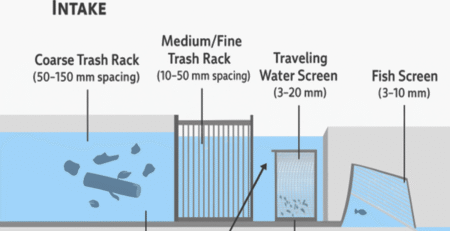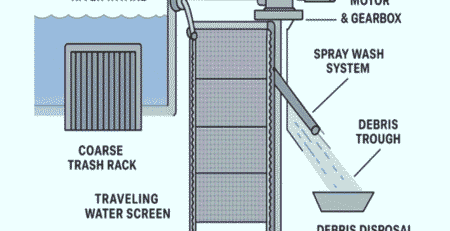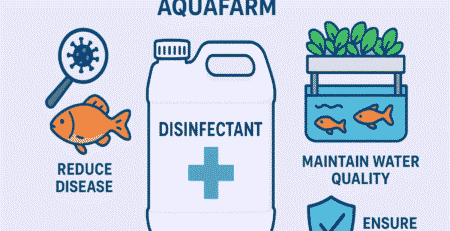Wastewater Treatment & Reuse of Textile Effluent
I’ll try to cover in this article on the technical data related about the textile industries like the actual water requirement, total consumption in the dyeing process, wastewater quality of the different processes, faced challenges, influent /wastewater temperature adjustment, installation of cooling tower and heat exchangers to reduce the influent temperature and their effective use how we improve the COD, BOD, effluent cleaning, process of effluent recycling, zero liquid discharge system and some of the energy aspect too, because along with water we have a lot of use of energy to run these machines or processes. So, then after I will discuss what we should do in our project, and what results we will achieve and what will be our recommendations based on the project of wastewater treatment and so that we can reuse the water and install it in textile industry.
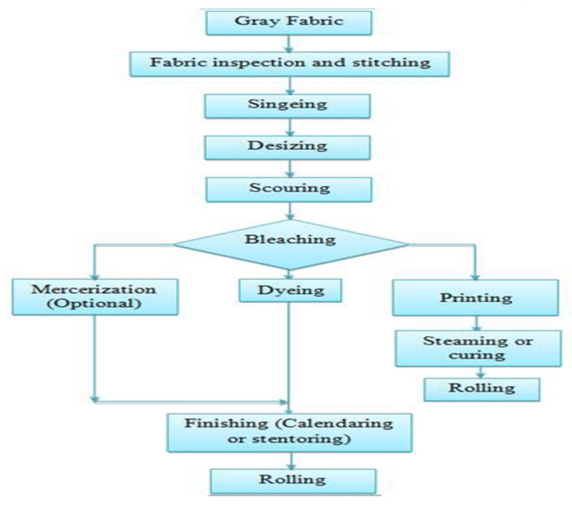 This article is just covering that when we have a textile goods or textile fabric or textile cloth and normally, we use cotton is the main textile fabric or in fibre farm or in cloth farm. So, basically textiles fabric looks yellow in colour, because cotton is naturally due to some natural colours and pigments it appeared as yellow in colour before it needs to be dyed or printed, it is processed bleached and alkaline and causticized to improve its absorbency its whiteness. So, we can colour it and finish it or print it.
This article is just covering that when we have a textile goods or textile fabric or textile cloth and normally, we use cotton is the main textile fabric or in fibre farm or in cloth farm. So, basically textiles fabric looks yellow in colour, because cotton is naturally due to some natural colours and pigments it appeared as yellow in colour before it needs to be dyed or printed, it is processed bleached and alkaline and causticized to improve its absorbency its whiteness. So, we can colour it and finish it or print it.
You can see there is a sequence of all the processes which we need to pursue just to make a textile fabric ready for its intended use.
It can be used as a home textile bedsheet, cartons or as aprons. So, all these processes are like bleaching and marginalising alkaline printing and dying all these processes are being done in presence of water. Because water is used as a medium to pursue every process. I will give you an example of a washing machine at every home we use to clean the dirt of textile fabric or textile garment by using the washing machine and washing machine run on water.
We apply detergent in water, and we have a soapy water to process or to perform the washing and rinsing at home. Similarly, we need water to perform all these processes in textile industries.
 If we take an example of these machines. These are really bulkier machines. As I mentioned some of the processes. You can see these are jumbo jet machines, each process is being carried on these machines to take bleach or dye the fabric and these are continuous machines.
If we take an example of these machines. These are really bulkier machines. As I mentioned some of the processes. You can see these are jumbo jet machines, each process is being carried on these machines to take bleach or dye the fabric and these are continuous machines.
A textile goods need to be transported from this machine for any processing like we are doing bleaching dyeing or printing and for every bath. So, it is half filled with water. There are around 10 to 15 baths in every machine. A textile goods is passing from all these baths and finally being treated and processor in any textile industry.
So, take an example that we have variety of machines from single bath to 15 baths chambers and every chamber is filled with around one cubic metre or 1200 litres of water and is the fabric is being continuously pass and conveyed from these processes. So, there is a continuous generation of wastewater there is a continuous use of water and there is a continuous production of textile garment either it’s bleached, dyed, printed, or finished.
This is the example of continuous processes. The production rate in textile industry is very high. Traditionally when we talk about textile processing or textile dyeing, we have the conventional bath, there are single cylinder drums, they are filled with water and some of the chemical recipes or some of the dyeing recipes. So, textile fabric is being passed continuously from this machine until we got the desired colour or bleaching or finishing of the fabric.
These machines use less water compared to the continuous machines, but their wastewater loading, or composition is very high. So, we have high COD and BOD release from these processes. These are conventionally being used Now, we have usage of this textile effluent treatment machines at the textile industry.
- They benchmark that around 80 to 20 litres per kilograms litres of water is being used while we are performing any process of textile industry
- Out of this conception 20 to 25% is excessive than the requirement actual requirement
- Out of it 10 to 15% can be managed easily and could be saved by configuring or by redesigning the process what we discussed in previous
- In Pakistan 80 to 90% of the textile industry wastewater which is generated, they are not processed and not treated well. So, they have directly been disposed in see or water bodies.
When we talk about the composition of wastewater coming from these industries like from textile industry. The textile industry wastewater recovery is very complex in nature, because we use a lot of chemicals and different types of the chemicals, some are hazardous like they are metal based compounds and VOCs based compounds and some are hard to treat they are on biodegradable.
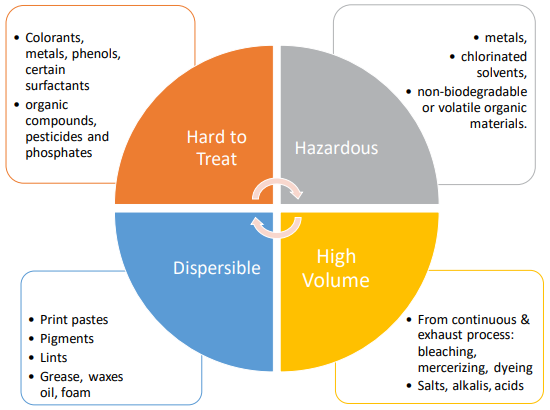 So, their treatment is very difficult, and some are the disposable compounds like oil and waxes and forms which are being applied for textile processing to perform some of the finishing operation and textile processes. one volume is also a high volume that takes textile industry wastewater is also of high volume means we are not talking about 1 cubic metre or 2 cubic metre or 10 cubic metres of what we are talking about 3000, 2000 cubic metre of water being generated on daily basis and they are severely contaminated with all these VOCs, metals and printing paste and die colourants and there are a lot of alkalis and caustic soda and many assets and ionic loading in the water.
So, their treatment is very difficult, and some are the disposable compounds like oil and waxes and forms which are being applied for textile processing to perform some of the finishing operation and textile processes. one volume is also a high volume that takes textile industry wastewater is also of high volume means we are not talking about 1 cubic metre or 2 cubic metre or 10 cubic metres of what we are talking about 3000, 2000 cubic metre of water being generated on daily basis and they are severely contaminated with all these VOCs, metals and printing paste and die colourants and there are a lot of alkalis and caustic soda and many assets and ionic loading in the water.
So, in nature, textile process generated wastewater is hard to decode and it’s very multidisciplinary in and complex nature. So, in detail if we talk about every process. some of the starch, waxy compounds, alkalis, dyes, and formaldehyde-based products and finishing agents, some of the printing pears, and gum and in some of the antibacterial finishes, which are applied on every process, they generate a huge amount of COD, BOD and high Ionic and organic loading in the wastewater system. It’s very important to consider the treatment of such ionic or high BOD or COD loading and after consideration, it is very critical to treat our wastewater with such with such composition.
In any country, because there is a lot of pressure by the international customers, like European and American customers, they are demanding textile industries to process their water and to treat their water and to reuse it as much as possible with Caustic recovery plants for textile industry, Effluent recycling plants, Zero Liquid Discharge Systems, etc.
These countries are working now on zero water discharge and zero discharge for organic compounds or the chemical compounds in effluents so, many industries, they have started to treat their water.
So, what they have adopted they have initially adopted the biological treatment and membrane biological reactors (MBR) treatment, and finally, RO treatments, intensive tertiary treatments and they are reusing and recovering around 60 to 70% of the water.
Our main target was to start in a reverse engineering way, because normally when we talk about any wastewater about the end of pipe treatment. When we have the mixed influent coming from any textile industry, we are focusing to treat that with Effluent treatment plants, or Caustic Recovery Plant for Textile Effluents, but in order to treat this very stream with a lot of variation and use of critical compounds.
It is important to understand first the process and the chemistry of the process, then to start the designing the operating conditions and parameter conditions for the wastewater treatment plant. So, what we will do, we started our work from production floor, we’re actually the textile production is happening.
So, we started with the processes that we discussed like
- We initially first studied the process and studied out the consumption patterns and wastewater composition from every process
- We came across on the designing of all the operating conditions in order to treat the mixed water which is coming from different streams.
- We knew first the chemistry then we designed the operating conditions of the wastewater treatment plant and also along with knowing the consumption and individual patrons of each process.
- we also studied that from there we can directly reuse or recycle the water without disposing it directly.
So, we can start this from any textile industry that can offer some of the financial contribution. We can go through their industrial needs, what they need.
we did some fundamental research then we transform that fundamental research into applied research that we implement for wastewater reuse and treatments for all the processes that can be implemented in any textile industry like Caustic Soda Recovery Plant, Effluent Recycling Systems, etc.
This is a chart of all the processes which are being done at textile industry. So, we studied all the patrons and consumption sequences of every process. we monitor the flows, and wastewater flows, and we also monitor which process generate a high accumulated water where the waste composition in water is very critical and where the waste composition is in diluted form, which could be recycled. So, all these processes we can investigate first before moving for the any wastewater treatment plant design. we can explore the on-site wastewater recovery options.
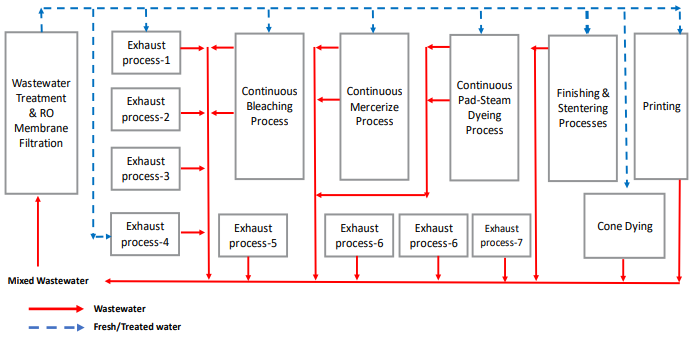 We analyse the COD, BOD and basic water quality parameters after each process and we can make an average that for each process, what number of COD and BOD and what number of TDs and pH and what are the ionic loads of each process. So, we can categorise the processes which are less loading, which have the few loadings, or which have the less composition of the COD, BOD.
We analyse the COD, BOD and basic water quality parameters after each process and we can make an average that for each process, what number of COD and BOD and what number of TDs and pH and what are the ionic loads of each process. So, we can categorise the processes which are less loading, which have the few loadings, or which have the less composition of the COD, BOD.
We can characterise them from the process with generate a high COD and BOD then after by covering all these processes individually, then we can study the mixed wastewater in correlation with the results what we got and then after we can start to design the operating conditions of the wastewater treatment plant and RO membranes.
Development of water management system
So, initially, what we do we can develop a water management system, which is very valid for every textile industry. We can work on five basic principles, we can ask, we are the processing, production crew or managerial staff.
- They should know and adjust the actual process water requirement
- They adopt some of the on-site water we use
- Management practices within their industry
- we can work on cooling water and steam condensate recovery.
- Effective water related maintenance
- Water consumption control through process/ chemical modification
So, I will cover in detail in preceding article that what is cooling water and what is the steam condensate and how it is important and why it is important and also, we can work on water related maintenance and also, we can modify some of the processes to save water on site or within the process rather focusing on the end of pipe treatment.
We can start to work first on the processing facility, where this water been used, and textile production has been followed.
Knowing/ adjusting the actual water requirement
This is basically a scheme of a machine continuous machine, it has nine washing chambers, in each washing chamber, there is a freshwater flow, and each chamber is filled with around 1 cubic metre or 1200 litres of water.
Textile goods are being passed or process from these processes. what we can do, we basically want to develop the Excel model, we can gave this model to the textile industry processing facility, we can ask them to fill this Excel model with the daily production and their water consumption. As we can relate that what does the actual requirement allow is for the kilograms of fabric being process like bleaching machine or bleaching process.
Normally a bleaching process can take around 30 litres of water for per kg processing. If we are producing a 1500 kg of fabric or textile goods, we are bleaching we need around 20 cubic metre of water per hour.
If this machine will be running for 10 hours, then our consumption will be 200 cubic metres, but if our flow metre and our production reading will be different. Then this model will compute the excess water consumption of this process and they will start working where the water leakage occurs and if the consumption of water is as per the requirement of the process or not or it’s higher or lower.
Water balance of continuous dyeing process
Similarly, we can design model computing model for dyeing process. So, in dyeing process they are 8 chambers of water or 8 boxes which are required to process this textile goods and we have water intake it chambers 3, 5, and 7. So, we can ask production dying facility at textile industry to fill this model with the daily production and water consumption.
So, as we can compute that what is the actual consumption going on at machine and we also compute the benchmark of this process this process needs 17 cubic metre per hour of water. But, if the consumption is higher, then we need to work on the machine if there is some leakage, or some faulty, some error is going on in this machine related to water consumption.
Consumption of exhaust dyeing process
We also can work on exhaust dyeing processes. So, these processes have liquor ratio. So, they use around for every 1 kg they use 6 kg of water. So, normally this is the liquor ratio, in any textile industry. So, we can compute according to this labour water liquid ratio, so, there is around 6 loadings from initially starting from the bleaching to dyeing the fabric and there is around 30 cubic metre of water consumption and we worked that if we have reduced down to one loading, and if we are combining the rinsing and neutralisation operation, so, we can save around 3000 litres per lot.
Even after we ask them
- To check their water flow metres on daily basis
- To compute the water balance models on daily basis
- To check the functioning of water controlling valves
- To have the process sequencing in a way that if we need to die single lot with red colour so red colour should run on the whole day.
So, there is not any change of sequence like if we will be dying or printing red colour or blue colour or yellow colour combined in one day. So, there will be continuous machine loading and this loading and unloading. When we have a new loading of water, so, there is a fresh consumption of water. We can ask them to improve the sequence.
Adoption and Management of on-site water Re-use
We can identify the streams where the wastewater which is generated is it’s in diluted form. So, it can be recycled in some of the prewashing stages. we can work on bleaching machines and we can recover while wastewater generated after this washing stage and there is a screening which is removing the suspended solids and finally, it can pump in the pre washing stage and also, they can use the heat exchanger which has been applied to recover the energy of this drain water for heating the fresh water and can run this machine and can run this process very effectively.
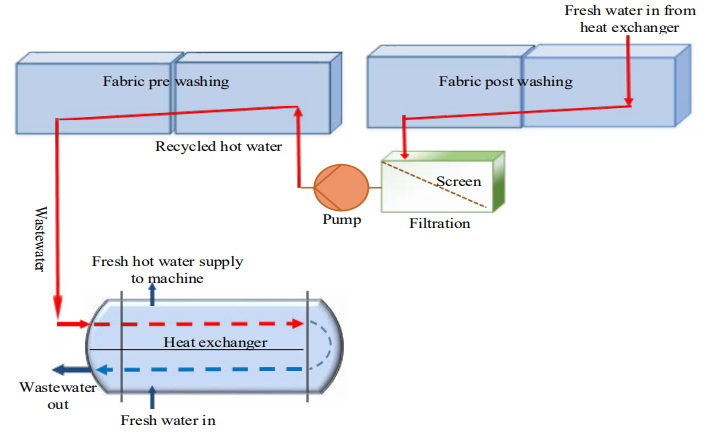 we can ask them to manage the cleaning of these heat exchangers and these screens on every shift have to allow.
we can ask them to manage the cleaning of these heat exchangers and these screens on every shift have to allow.
Management of cooling water recovery
Cooling water is termed as the water which has been used for cooling of the drums and some of the hot medium. So, in textile industry, there are a lot of rollers and cylinders, which got heat after the process.
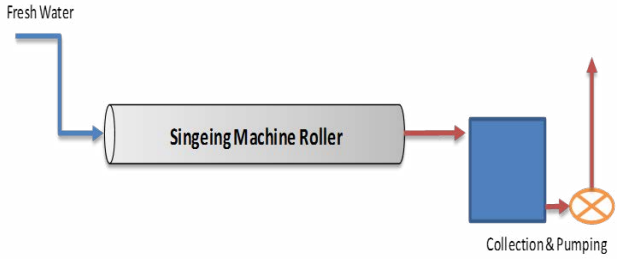 They are being cooled down by using the fresh water. we can identify some of these spots, where cooling water is being drained directly without its recovery. So, we can ask them to deploy the pumps and to recover this water and to recycle this water and recollect this water.
They are being cooled down by using the fresh water. we can identify some of these spots, where cooling water is being drained directly without its recovery. So, we can ask them to deploy the pumps and to recover this water and to recycle this water and recollect this water.
So, at this one machine, they can save around 1000 gallons by doing the simple practice by only recovering and pumping it back to the system.
Management of steam condensate recovery
Normally condensate in textile industry can be used for steam. So, saturated steam is being used for heating these mediums.
when saturated steam is being applied for heating the baths or chemical baths or water baths it’s become condensate. It condenses out while transferring it heat to the water it condensed out and it needs to be collected and transported back in the feedwater system which is feeding the water for the towards the steam boiler.
This steam boiler is basically producing steam, supplying the steam to the process and where from we have this recovery of condensate again in the system. Normally these condensate pumps got failed a textile industry. So, condensate is being drained directly and it’s been mixed with the effluent or wastewater.
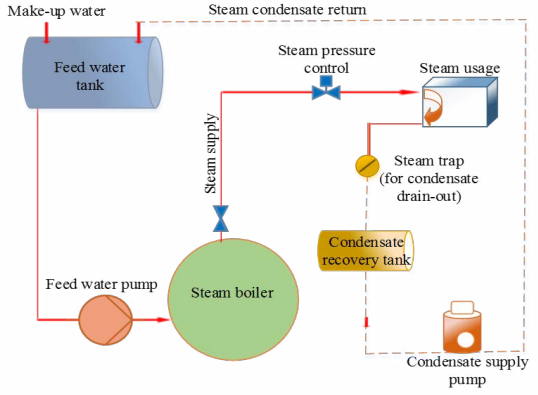 We can identify some of the condensate recovery pumps which may be fail in textile industry. Because of this temperature in their wastewater is very high and when we have a high wastewater temperature, it is very difficult to biological treated.
We can identify some of the condensate recovery pumps which may be fail in textile industry. Because of this temperature in their wastewater is very high and when we have a high wastewater temperature, it is very difficult to biological treated.
Effective water related maintenance
Water related maintenance is very important. It is very important to check that water is not directly been drained or water valves are not manually open, and we can a proper calibrate flow metres and water controlling valves which are basically controlling the water intake as per the requirement of the process. So, with respect to time, they got failed. So, they need to be monitored and checked on regular basis to run it effectively to manage the water balance.
Water reduction through chemical modification
With small modifications we become able to save a lot of water within the process. Without being working on wastewater zero discharge at wastewater treatment plant, we can save a lot of gallons in within the process. These are just the examples that we can coat and save some of the amount by avoiding the rinsing cycles, excessive rinsing cycles, and some of the recovery of condensate and some of the reduction of the water loading it. We reduce also in the liquor ratio from 1:6 to 1:5 and it saves around 1100 gallons of water consumption for per 1000 of fabric.
Other method we can consider even we can have the combined neutralisation and rinsing procedures, while we are doing exhaust dyeing and we can reuse the dark shades, dyeing water in lighter shades and also we can improve the colour fixation by using some of the chemical fixers because in dyeing process around 20% of the colourants we apply they are not fixed on the fabric or textile goods, they got transported with the water.
There is a wastage of 25% of colour. So, now textile industries they are focusing on chemical use of chemical fixer, to fix the colour and to improve the colour fixation and to save this colour which has been draining with the water.
Layout of wastewater / Effluent treatment plant
After working on the industrial processing facility finally, we approach to the wastewater treatment plant. They have the primary treatment which is physiochemical treatment use of coco lent and influent then they have the aeration basin and after this aeration basin they have the membrane treatments.
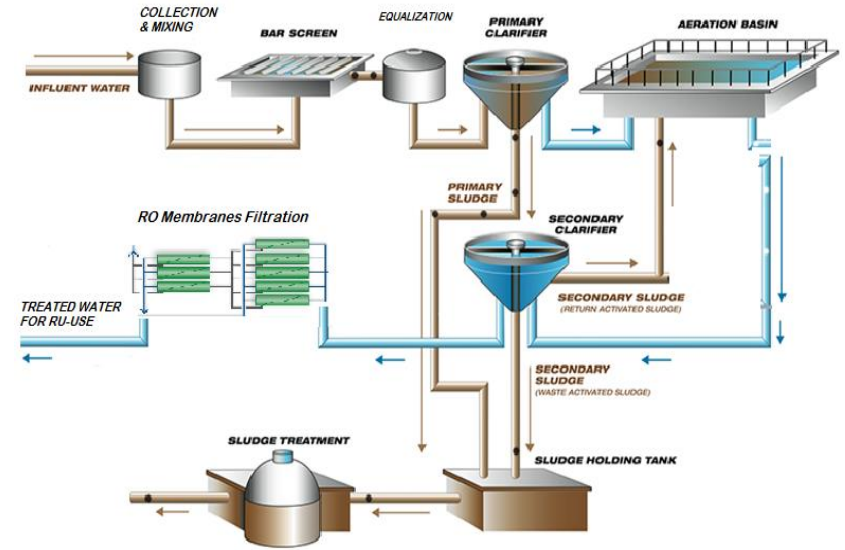 After following all these procedures any textile industry can recover around 60% of its water by using these physio-chemical and biological processes and finally, the RO membrane filtration.
After following all these procedures any textile industry can recover around 60% of its water by using these physio-chemical and biological processes and finally, the RO membrane filtration.
You can perform the sampling at the inlet and after every stage to analyse the performance of each process being taken at the wastewater treatment facility at any textile industry and we can closely monitor every stage with the amount of COD and BOD loading and ionic loadings in order to control the designing parameters.
Average wastewater quality of different process
We first summarise the average COD and TDs load from every process. So, we came across that bleaching processes they have the highest security loading, because of the use of the chemicals and some of the exhaust processes they have COD loading because of the less amount of water and also the ionic load was very high from bleaching operation and from mass pricing operations because of the use of the caustic soda.
Finally, we summarise we correlate with the results we got in the mixed effluent after each process. In many textiles industry we can face problem that there COD, and BOD loads may be very less. So, the biological treatment will be very difficult, because of the low nutrient and food to microbe ratios.
So, this plant we suggest is designed to treat 2500 COD, but some textiles industries recovering having around 1000 COD of average. So, it may be difficult to perform the biological treatment. we can test wastewater at our centre, and we run around three cycles, three batches with some of the seedings by nutrient seeding like off dyeing and urea. So, we can identify that we are able to achieve the 95% of COD removal by using some of the inoculants in the wastewater.
We can perform the fluorescence in situ hybridization to see the microbial colonies in the wastewater and we can detect some of the microbial community being stabilising and generating in the wastewater treatment facility at textile industry by managing it with the supplement nutrient addition.
Faced challenges
- As I mentioned earlier that temperature is very critical issue in mixed wastewater in textile industry. So, for this temperature 55-65 degree, we cannot perform any biological activity. So, the biological growth is very less.
So, we can ask them to instal this cooling tower to reduce the temperature of wastewater which has been coming for from the textile industry just to perform the biological activity.
- There was another challenge that as I mentioned that BOD and COD ratios very less (less than 0.3). So, also there was not any feed for the bacteria to grow.
We manage this ratio by nutrient loading from jiggery, urea and animal dung to increase the biological growth and biological activity in the aeration basin. Normally textile industry they have the COD loading of around 2000 to 3000. But in normal textile industry, that are towel based industry, they have the COD load of around 1000 milligrams per litre, which is very difficult to be controlled, because it’s very less COD nutrient loading for any biological activity to perform.
we highlighted in our working that they can use of poly vinyl alcohol (PVA) and volatile fatty acids (VFA). So, they can pass in from the clarifiers towards the membrane, and there will be the choking of membrane. They must be requiring immediate flushing after a 3- or 4-hour cycles. We can separate these polyvinyl alcohol and volatile fatty acids, streams from the streams which are being treated by biological basin and membranes just to avoid this problem.
Developed WW operation conditions
We can develop four scenarios out of all the conditions we can face or challenges in textile industry.
We summarise these four scenarios, depending on the conditions what we challenge we faced at textile industry, and we asked them to maintain all these conditions just to run this wastewater treatment facility in a very efficient or smooth way.
RO membrane operation
Finally, for membrane operation, we can study the membrane operation for up to three months and we continuously been looking at the TDs load which are coming in the permeate and also the feed quality and we are able to achieve around 60% recovery by managing the smooth operation of RO and we also considered some of the key consideration for RO operation.
We can ask them to have a good anti scaling used and managing of the silk density index and some of the organic load feeding avoidance and basically when high organic load which is received after secondary treatment. So, there is a chance of failed membrane. So, we may be able to achieve less than 30 COD for RO feed.
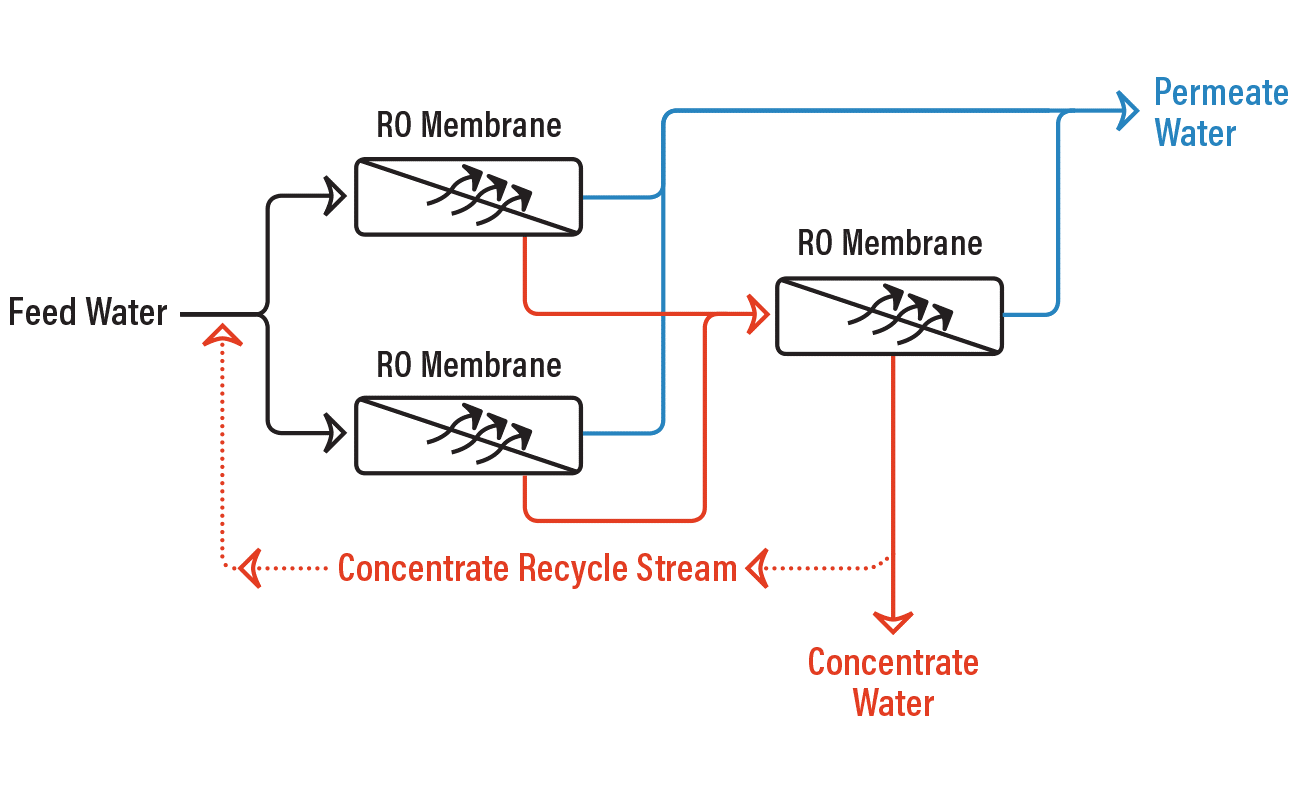 So, when we achieve this less than 30 PPM COD of load or as a RO membrane feed, we will be able to achieve some of the good recovery and some of the good back washing frequency and also, they are now working on caustic recovery. So caustic recovery they can there is a lot of ionic loads in form of caustic in form of sodium coming from the machine or from the processes, so it’s been difficult to treat.
So, when we achieve this less than 30 PPM COD of load or as a RO membrane feed, we will be able to achieve some of the good recovery and some of the good back washing frequency and also, they are now working on caustic recovery. So caustic recovery they can there is a lot of ionic loads in form of caustic in form of sodium coming from the machine or from the processes, so it’s been difficult to treat.
So, all these ionic loads are being accumulating on the membrane. So, we can put some recommendations to use caustic recovery and optimise use of the coagulant and also, we can recommend them currently they have the sand filter as RO primary feed, but we will recommend using ultrafiltration membrane just to increase the efficiency of RO membranes.
Achievement after installation
These achievements and these targets and development of our management system, we are able to achieve around 2 lac gallons of water per day and also, we stabilise the wastewater treatment plant operation and we can also recover some of the energy in form of steam condensate recovery and use of heat exchangers and also, we can develop for scenarios and different development conditions for running a wastewater treatment plant more effectively.
Because for textile industry due to a lot of process variation, it is very difficult to manage the wastewater treatment plant operation. So, we can design some of the conditions that are related to the changes in the process and similarly to tune the wastewater treatment plant accordingly.
Textile Wastewater Treatment Frequently Asked Questions
1) What are textile effluents?
Pollutants include hazardous metals, dyes, dissolved solids, and suspended particles are commonly found in textile wastewater. Total dissolved solids are the primary aspect of textile effluent to be taken into account (TDS). The amount of TDS in textile wastewater rises as a result of the use of common salt and Glauber salt.
2) What are the characteristics of textile effluent?
Textile wastewater contains metals such manganese, sodium, lead, copper, chromium, and iron as well as significant levels of suspended particles, TDS, chlorides, nitrates, and BOD and COD. Dark brown also characterizes the water.
3) How many steps are there in effluent treatment?
The primary, secondary, and tertiary water treatment stages are the three main phases of the wastewater treatment process. More sophisticated treatment, or quaternary water treatment, is necessary applications.
4) What is meant by chemical modification?
The process of anatomically interacting a protein or nucleic acid with a reagent or reagents is known as chemical modification in biochemistry. Using chemical modification to gather data in the lab, one can figure out which sections of a molecule are exposed to a solvent.
5) What are the steps of wastewater treatment?
Wastewater Treatment Process
- Preliminary Treatment. Screening and Pumping.
- Primary Treatment. Next, the wastewater enters primary settling tanks where the flow of water slows down, coagulation, flocculation.
- Secondary Treatment. Aeration and Final Settling.
- Tertiary effluent treatment, Disinfection.
- Sludge Treatment.
- Waste-to-Energy.



